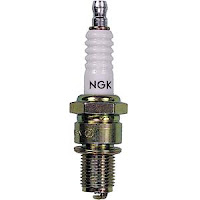When we "stored" the CB200 it was running good. I turned off the petcock and proceeded to move it around the garage for 6 years occasionally wiping off the top layer of dust.
Ed Note: This is not the correct procedure for storing a motorcycle nor is it the correct procedure for starting a motorcycle that has been sitting for years.
First the throttle wouldn't turn. It was stuck. I followed the cables down to the carburetors and the left one would pull out the slide the right one was stuck. I unscrewed the cap and realized the fuel had varnished in the carburetor. I decided to remove the carb and give it a "good" cleaning.
 How to remove a carb on the CB200
How to remove a carb on the CB200There are a pair of Phillips head screws that hold the carburetor onto the intake runners. I found that a 1/4 wrench with a Phillips bit taped into the closed end of the wrench gave me a short enough throat (my fancy dual 90 Phillips head screw driver was too long the bend ran into the intake bolts.) and the angle of the wrench was perfect so I could actually turn the screws a quarter turn at a time. Its not fast but the more you do it (and believe me you will do it a lot) you'll get faster.
Once I had off the carburetor unscrewed from the intake I was able to put a little gas into top of the carb and put a screwdriver in through the air intake and pushed the slide out of the top. It was n't pretty but I got the carb off the bike and wiped it down, cleaned the slide and put it back together.
Do as I say not as I do.If you are here stop. Pull the tank and petcock, pull both carbs do a real cleaning. Get a couple of rebuild kits and do it right the first time. You might as well because as this story goes on I will R&R the tank and the carbs multiple times and eventually do it right.
The throttle cable was free and I could twist it as designed! I turned on the petcock and tried the electric starter. Click, click, click. So down the street like the Jamaican bob sledding team. Run, jump on, second gear, pop the clutch. Pop, pop, sputter, sputter, seemed to run for about 3 seconds then nothing.
I hooked-up the battery up to a charger over night and did the same drill the next day. Click, click, click. So down the street like the Jamaican bob sledding team. Run, jump on, second gear, pop the clutch. Pop, pop, sputter, sputter, seemed to run for about 6 seconds the nothing.
The next day I sent my son to the local Honda dealer who ordered a $30 battery for us and the guy at thee parts counter told him all about the CB200 he had when he was younger. He rode his to Joshua tree with a bunch of "big" bikes. He said had it pegged at 70mph the whole way but he kept up! (People... ok young people, actually ride these things.)
While we were waiting for the battery to come in we decided to see what was in the fuel tank. So we removed the tank. (Open the seat, pull back the rubber saddle, pull the fuel lines of the petcock, pull the tank back. Easy, no tools necessary. Gotta love Honda engineers.) I dumped the tank into a clear plastic container. It didn't look like gas, it didn't smell like gas, it was a reddish-brown varnish.
As gas sits it evaporates leaving behind the other stuff in gas, mix that with rust in the tank and you have a toxic waste dump. The fact that the Honda "ran" for 9 seconds on this crap is a miracle. I removed the petcock and we flushed the tank with water and floated all the crap out of the tank. I disassembled the petcock and found it was all gummed up with the reddish-brown varnish I saw on the carb slide. I got it all cleaned up pretty good and we put it all back together.
 It lives.
It lives.When the battery came in we went down to the gas station and got a gallon of premium (only the best, right?) we hooked up the fresh battery (the dealer filled it with acid and charged it for us.) Guess what? It fired right up. We took it for a spin around the block and felt a sense of accomplishment. The only problem, it ran like crap and immediately fouled the right plug.
Here's some good advice:
http://en.allexperts.com/q/Motorcycle-Repair-837/CB200T-Engine-miss.htm











































